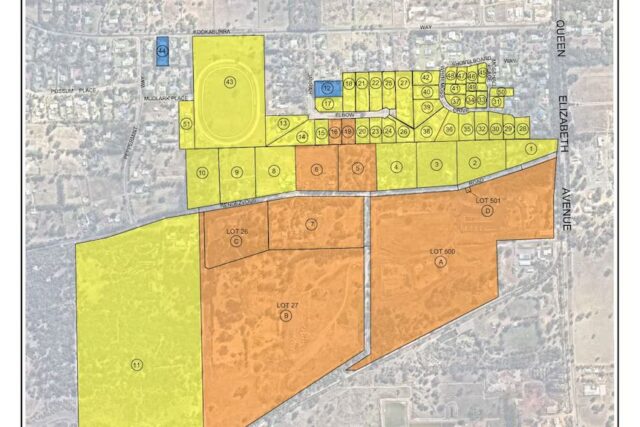Toxic sludge contaminates groundwater at 50 Busselton properties from 1960s landfill
https://www.abc.net.au/news/2023-05-04/50-properties-busselton-toxic-waste-contaminates-groundwater/102291952
Owners of 50 properties sitting on bush blocks in a tourism hotspot within West Australia’s South West have been told their groundwater has been poisoned by toxic sludge from the town’s old waste facility.
Last month the Department of Water and Environmental Regulation (DWER) placed groundwater restrictions on the Busselton properties, two-and-a-half hours south of Perth, due to the presence of toxins such as hydrocarbons, metals and per- and poly-fluoroalkyl substances (PFAS).
Five landowners have been told that their groundwater is so contaminated that it should not be used at all.
The other 45 have been advised that their bore water should not be used for consumption, swimming or for watering edible plants, but is safe for general irrigation.

A diagram showing the extent of contamination from the old Busselton rubbish tip. Houses marked yellow can use their groundwater, but not for consumption, while the ones in orange cannot use their ground water at all. ()
Scheme drinking water is unaffected by the contamination, and testing has shown that the contamination levels have remained stable over time.
The site was a landfill between the late 1960s and 2012 and is now only used as a waste transfer station.
An independent audit detailed the uncontrolled nature of the landfill site, including anecdotes of oil, grease and pesticide drums popping when the landfill was compacted by bulldozers.
“The water table was generally very close to the surface and waste was occasionally buried below the water table,” the report said.
“The types of wastes buried at the site included animal carcasses, asbestos … car batteries, car bodies, fridges, green waste, drums of oil, hydrocarbons and asphalt, various chemicals (including paints, solvents, herbicides/pesticides), soil and wastewater.”
Authorities first classed the old landfill site as contaminated in 2007, but 10 years later testing revealed potentially harmful plumes had spread to nearby residential areas.
Since then, residents have been told not to use their groundwater while the investigation occurred, which involved testing for PFAS in produce grown in the area.
Compensation on the cards
Chief Executive of the City of Busselton Tony Nottle said it would work with those impacted.
“The city is in the process of meeting with affected landowners to discuss the outcomes of the investigations into contamination issues,” he said.
“These discussions are confidential.”
As a result of the classification, property owners will be forced to put the contaminated status on their house title, potentially impacting future sale values.
Owners have been told by authorities that if they fail to notify future buyers they could receive a fine of up to $125,000.
When asked about the possibility of compensation, Mr Nottle confirmed money had been put aside to “resolve issues” with private landowners.
“Provision has been made in the city’s budget for complying with the statutory obligations in relation to contamination issues, as well as for resolving issues arising from the impact on private properties,” Mr Nottle said.
“The City of Busselton acknowledges that restrictions on the use of shallow groundwater and associated property classifications could impact on affected landowners.”
The city council has given landowners until the end of May to indicate what next steps they’d like to take.
It has refused to put a figure on previous compensation payments or how much money has been put aside to deal with issues at the site.
However, budget documents show a $2-million reserve called “Busselton Landfill cost-closure capping, rehab and remediation”.
The city council has also been spending money compensating landowners who have been using scheme instead of bore water.
That assistance program is set to wrap up in June this year.
Contamination ‘needs to be stopped’
Both the city council and DWER have been unable to reveal any long-term solutions for dealing with the contaminated area.
Mr Nottle says solutions have been identified but consultation comes first.
“DWER indicated that final decisions in relation to long-term solutions have been made and that they are in the process of notifying all stakeholders,” he said.
Professor of Sustainability at Curtin University Peter Newman has been studying the toxic effects of old landfill sites since the ’70s.
He said the practice should have ended sooner.
“I told the state government about it over and over during the 70s: ‘We have to stop leachate from landfills because it is going to get in and contaminate groundwater,'” Professor Newman said.
“They are required [to line landfill cells] now.
“But it took too long and in that period we’ve developed this pollution problem.
“You can imagine that those households would have a very good case to take to court and say, ‘The value of our land is significantly impacted.'”
Professor Newman said the contaminated land should not be left to future generations to fix.
“We have to find the money to clean them up,” he said.
“It is going to continue leaching into the groundwater for a very long time and it needs to be stopped.
“It needs to be dug out and [a] proper barrier put in and they need to extract the groundwater and clean it up.
“We should not be leaving that to another generation to look after.”